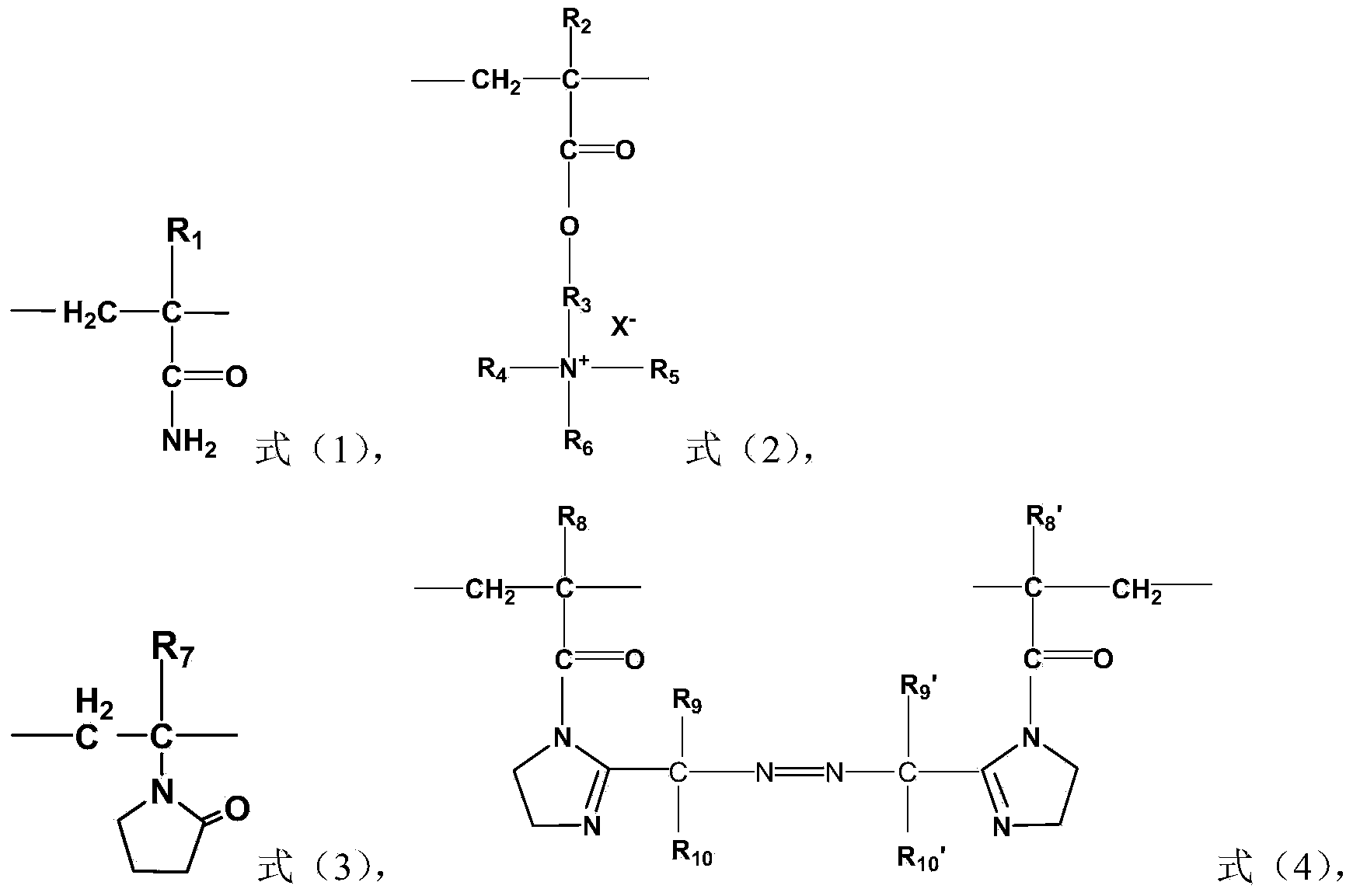Acrylamide copolymer, preparation method and application thereof
An acrylamide-based, copolymer technology, applied in chemical instruments and methods, drilling compositions, etc., can solve the problems of shale permanent damage, long dissolution time, polluted formations, etc., to reduce formation damage, prepare The method is simple and the monomer conversion rate is high
- Summary
- Abstract
- Description
- Claims
- Application Information
AI Technical Summary
Problems solved by technology
Method used
Image
Examples
Embodiment 1
[0080] This example is used to illustrate the preparation of acrylamide copolymer by the solution polymerization method provided by the present invention.
[0081] At room temperature, 4.26g of acrylamide (AM), 74.68g of M1 monomer represented by formula (13), 19.67g of N-vinylpyrrolidone (purchased from Sigma-Aldrich, the same below) and 1.16g of M2 represented by formula (14) (prepared according to the method described in Example 1 in JP08217755A, the same below) was added to the reaction flask, and 565.36 g of deionized water was added, stirred to completely dissolve the monomer, and stirred evenly. 5.5 g of 1% by weight of EDTA aqueous solution, 2.1 g of 1% by weight of 2,2'-azobisisobutylamidine hydrochloride aqueous solution, and 1.1 g of 0.1% by weight of sodium bisulfite solution were added to the flask, Urea 0.12g, stir well to make it evenly mixed. The pH was adjusted to 7.5 with 1% by weight sodium hydroxide solution. The initial temperature of the system was cont...
Embodiment 2
[0087] This example is used to illustrate the preparation of acrylamide copolymer by the solution polymerization method provided by the present invention.
[0088] Add 29.85g of acrylamide, 5.80g of M3 monomer represented by formula (16), 16.54g of N-vinylpyrrolidone and 0.46g of M2 monomer represented by formula (14) into the polymerization bottle, add 122.85g of deionized water, stirring to completely dissolve the monomer, respectively adding 4.65g of 1% by weight of EDTA aqueous solution to the flask, adding 1.23g of 1% by weight of azobisisobutylamidine hydrochloride aqueous solution, and adding 0.1% of sulfurous acid Add 0.11 g of urea to 1.15 g of sodium hydrogen solution, stir well to make it evenly mixed. The pH was adjusted to 7.1 with 10% by weight sodium hydroxide solution. The initial temperature of the system was controlled to 10°C, and after 30 minutes of nitrogen deoxygenation, 0.45 g of 1% by weight ammonium persulfate aqueous solution was added and nitrogen d...
Embodiment 3
[0093] This example is used to illustrate the preparation of acrylamide copolymer by the solution polymerization method provided by the present invention.
[0094] At room temperature, 25.53g of methacrylamide, 51.07g of M3 monomer represented by formula (16), 4g of N-vinylpyrrolidone and 0.002g of M2 monomer represented by formula (14) were added to the polymerization In the bottle, add 120.9g of deionized water, stir to dissolve the monomer completely, add 11.63g of 1% by weight of EDTA aqueous solution to the flask, add 2.13g of 1% by weight of azobisisobutylamidine hydrochloride aqueous solution, add 0.1% by weight of sodium bisulfite solution 1.13g, add 0.20g of urea, stir well to make it evenly mixed. The pH was adjusted to 7.3 with 10% by weight sodium hydroxide solution. The initial temperature of the system was controlled to 8°C, and after 30 minutes of nitrogen deoxygenation, 0.4 g of 1% ammonium persulfate aqueous solution was added and nitrogen deoxygenation was c...
PUM
 Login to View More
Login to View More Abstract
Description
Claims
Application Information
 Login to View More
Login to View More - R&D
- Intellectual Property
- Life Sciences
- Materials
- Tech Scout
- Unparalleled Data Quality
- Higher Quality Content
- 60% Fewer Hallucinations
Browse by: Latest US Patents, China's latest patents, Technical Efficacy Thesaurus, Application Domain, Technology Topic, Popular Technical Reports.
© 2025 PatSnap. All rights reserved.Legal|Privacy policy|Modern Slavery Act Transparency Statement|Sitemap|About US| Contact US: help@patsnap.com



